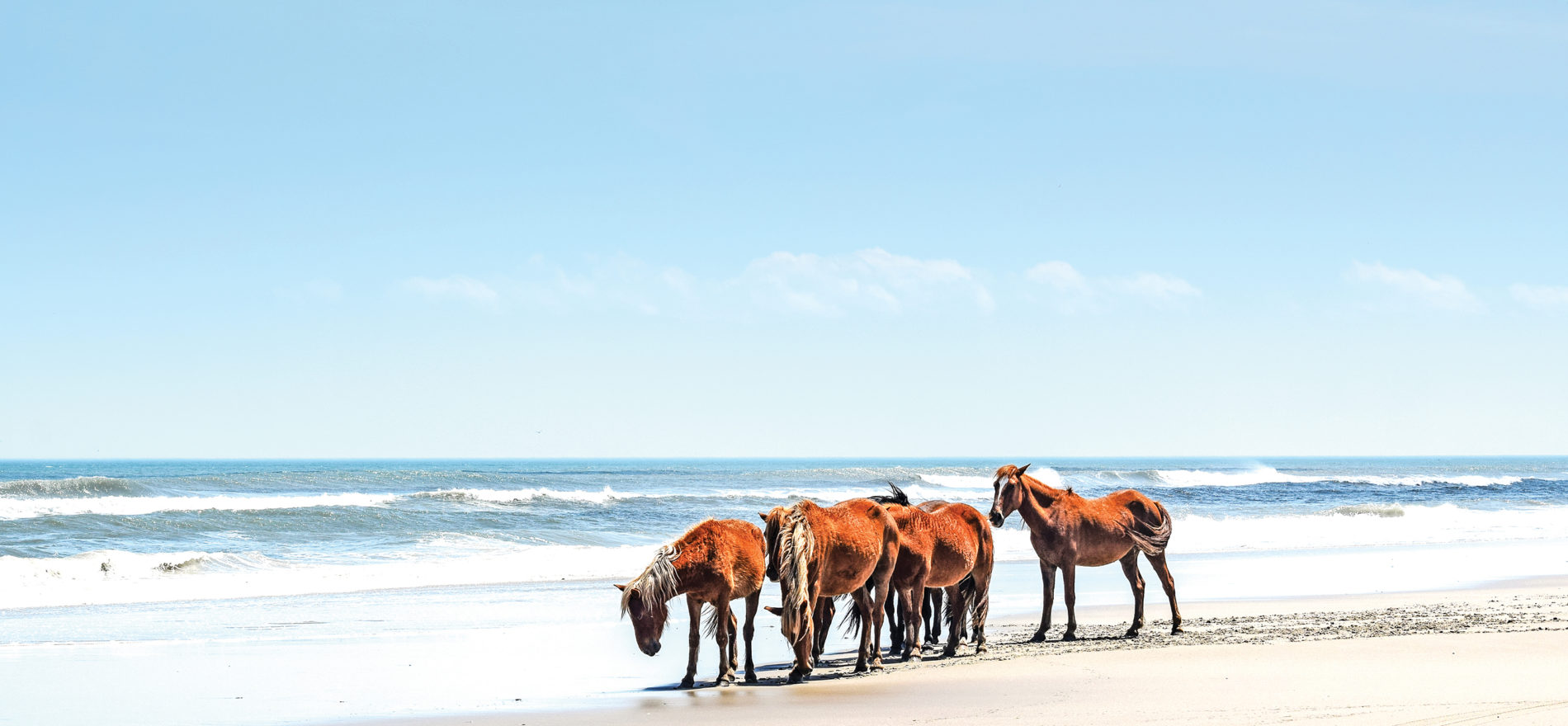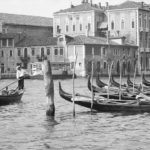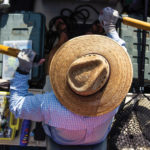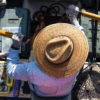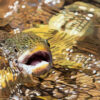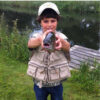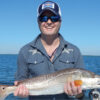“Hold on to your hat,” the tour driver said with a laugh.
He wasn’t kidding. Hats take flight during the excursion and are part of the experience. Even with good-natured warning, all 13 of us in the oversized Hummer were giddy with anticipation. Sitting in the back row proved to be a bit of a roller-coaster “high,” but the ride was worth every jubilant minute.
We rolled down Highway 12 to see the wild, Colonial Spanish Mustangs of Corolla (pronounced Kah-rawl-ah), on the way to the sandy beaches of North Carolina’s Outer Banks. It is nature at its best with a history lesson thrown in—the horses date back to the 1500s, when Spanish explorers introduced them to the region.
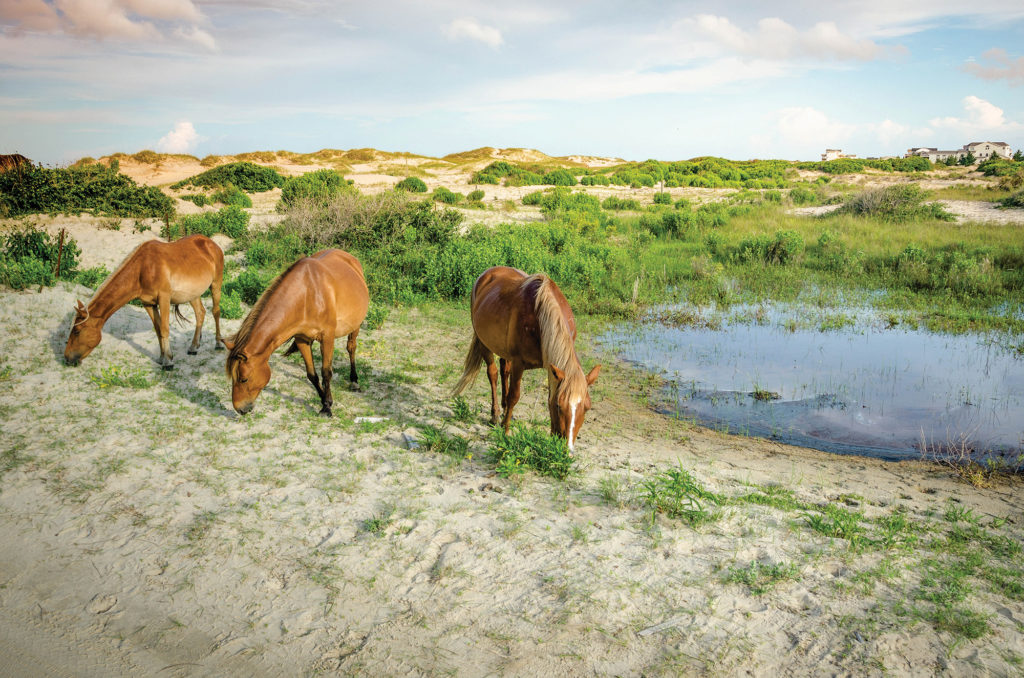
In season, the native, wild horses are a major draw for tourists. They are also a beloved part of everyday life for locals, who are accustomed to seeing them on the northern beaches of Corolla and smaller community beaches of Swan and Carova (Carolina and Virginia).
The tiny Outer Banks town of Corolla grows from 1,000 residents to nearly 60,000 people in the heaviest tourism months, which occur May through October. Aside from the beaches, the horses are the main attraction. The Corolla herd is one of two wild Colonial Spanish Mustang herds left in the world; mustangs in the other herd are called Shackleford ponies and live in Shackleford Banks, which is also located in the Outer Banks.
The best way to see the horses is with Wild Horse Adventure Tours (WHAT). The two-hour tour is a once-in-a-lifetime experience connecting people with horses and landscape, albeit from a safe distance. A strict local ordinance protects the horses and prohibits tourists from getting closer than 50 feet. During peak season, nearly 50,000 visitors take the WHAT tour; 25 tours are given each day.
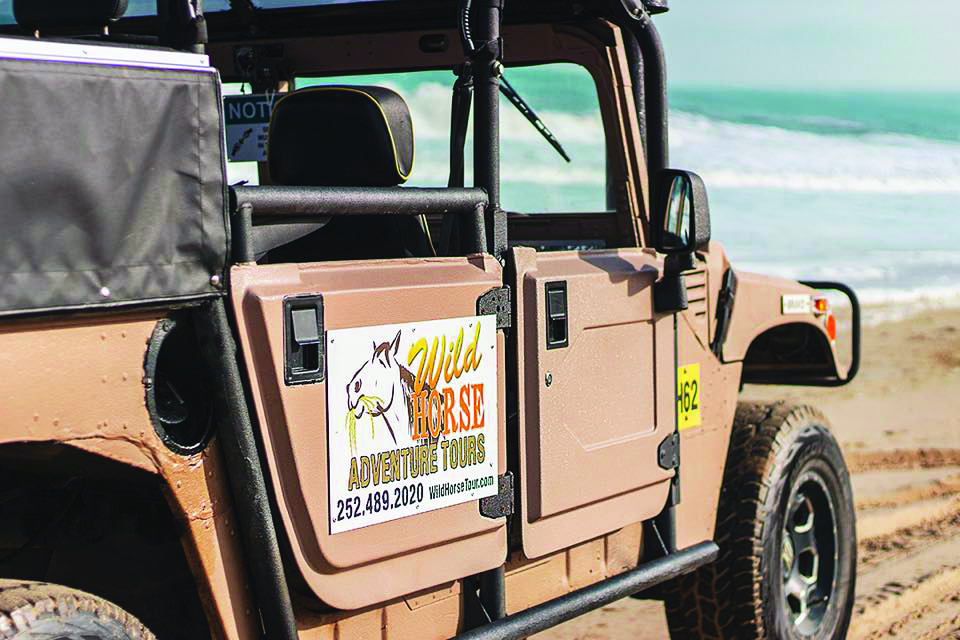
Highly trained WHAT tour guides are schooled in history and knowledgeable about the terrain, environment and horses. WHAT training is intense, and guides must pass a comprehensive test before getting behind the wheel of custom-made Hummers with open-air “windows.” WHAT refurbished eight H1 Hummers for the tours. Using Hummers was the idea of Richard Brown, a WHAT owner and self-taught mechanic; he knew only 4×4 vehicles can maneuver sand and thought Hummers would be perfect for the beach tours.
“Out of our concern for preservation and respect for the horses, we try to make the tour more educational and less about tourism,” said WHAT General Manager Pete Cole. “Our Hummers help make the beach safer for horses by lessening the number of vehicles on the beach.”
It did not take long before we spotted harems of mustangs on the beach. Unfazed by vehicles that are a part of everyday life, the majestic horses gathered at the water’s edge. It was a perfect moment, and the scene resembled a painting with a background the color of a Carolina sky.
The Corolla herd is made up of approximately 100 horses that live in Corova—the oldest community in the North Corolla beach area—and Swan and North Swan beaches. Herd numbers fluctuate slightly, and six foals were born in 2019.
Our entertaining guide drove us into hidden alcoves with “neighborhoods” where we could observe wild horses in nature. Off the main beach, houses mix with terrain; pine trees and wood-like foliage resemble Old Florida. At times, horses took breaks from the beach to relax and eat in the shade. Mustangs are smaller in stature than most horses; the guide explained they are typically 13-14 hands high. He told us that nearby homeowners also had to follow the same restrictions and stay 50 feet away from the horses.
The respect that WHAT has for the horses is equally matched by another organization’s respect: The Corolla Wild Horse Fund (CWHF). The nonprofit’s mission is to protect the horses, preserve their environment and educate the public. By way of aerial view, helicopters keep close tabs on herd numbers throughout the year. The count is critical; dwindling numbers have put the horses on an endangered list. In the 1920s, the horses numbered around 6,000, but time and mankind have taken a toll.
A herd manager and staff monitor the health and behavior of horses on a daily basis. They also study herd interactions. Horses are free to live naturally off the land for food and water. Contraception is used on mares more than 10 years old to protect horse and herd health and lessen birth defects.
A mustang’s wild diets consists of sea oats, grasses, acorns, persimmons, an invasive plant (phragmite) and milfoil, a sub-aquatic plant that grows in manmade canals. They do not receive supplemental feeding but are closely monitored throughout winter months. Water sources include the Currituck Sound, a freshwater estuarine system.
CWHF Director Jo Langone said the distance requirement keeps horses and people safe.
“An exception is made when a horse is too ill to recover from an injury or sickness without medical intervention, or if a horse becomes too relaxed around people,” Langone explained.
In these instances, CWHF permanently relocates compromised horses to its 30-acre rescue facility for rehabilitation. The facility treats horses with critical illnesses, life-threatening injuries or habituation issues. The relocation is permanent because reintroducing a rehabilitated horse to the wild herd could result in the transfer of domestic diseases. It would also be challenging for these horses to adjust back to life in the wild.
Langone acknowledges that wild horses of Corolla are self-sufficient and hardy, as they have been for centuries. However, in September 2019, Hurricane Dorian struck near Cedar Island and 28 horses died, diminishing the herd of 49 by half.
“Horses have natural instincts to protect themselves, but in the case of Dorian, it happened too fast,” said Langone. “The water surged to eight feet within an hour and the horses had no time to escape.”
The tragedy hit the equine community hard, but fortunately the animals are resilient. New foals are born, and herds continue to thrive thanks to WHAT and CWHF. Both organizations are dedicated to educating the public and preserving an important 500-year legacy. A beach with wild horses—what could possibly be better?
Lynne Brandon is a regular contributor to North Carolina Relocation magazine, South Carolina Relocation magazine and Doc Lawrence publications in Atlanta. She is also a contributing editor to Business NC, Triad Living and other North Carolina tourism publications.
Cover photo courtesy Currituck OBX
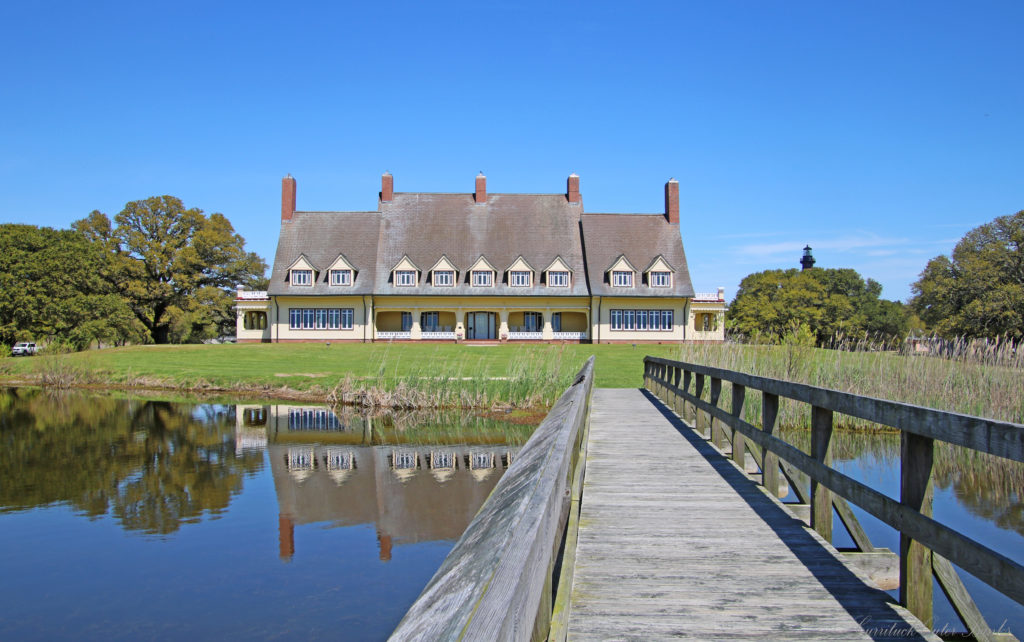
See & Do
There’s plenty to see and do in Corolla. Highlights include Wild Horse Adventure Tours, Currituck Lighthouse and Whalebone.
Wild Horse Adventure Tours
Beside the adventure, a portion of the proceeds from the tours goes to the CWHF and is used for herd medical emergencies.
wildhorsetour.com
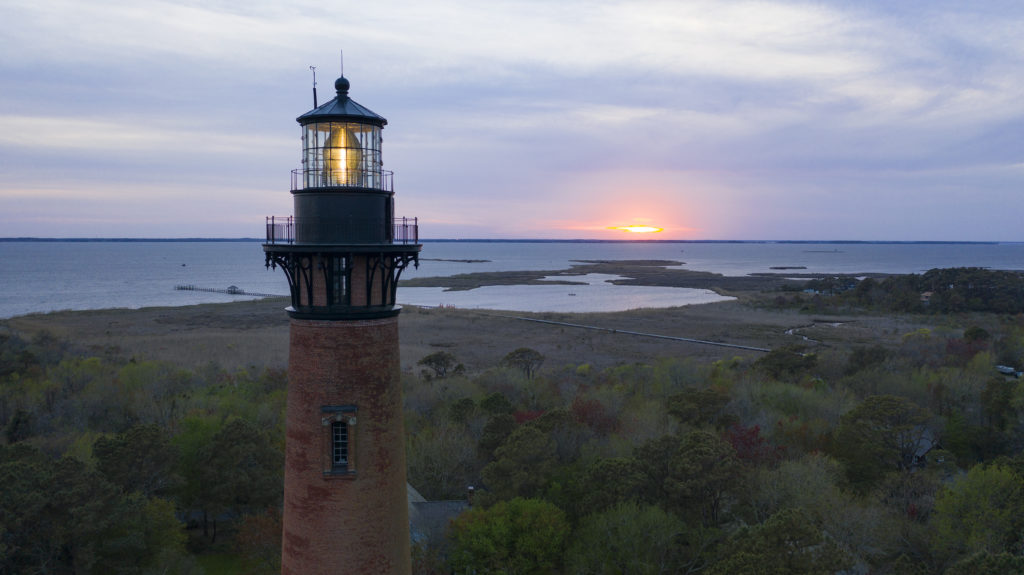
Currituck Lighthouse
The lighthouse—with its distinctive red exterior—still functions as a guide for passing mariners. Make sure to climb to the top; the view is the reward.
obcinc.org
Whalehead
Step back in time and visit a beautifully restored, Art Nouveau-style home built in the 1920s. The historic home is set on 39 pristine acres along the Currituck Sound in Historic Corolla. It is closed in winter.
visitcurrituck.com/things-to-do
Eat & Drink
Plenty of good food awaits in the Outer Banks but try these four standouts.
North Banks Restaurant & Raw Bar
Try the Colossal Lump Crab Grenades: tempura-battered giant lumps of crabmeat for starters. Then enjoy the yellow fin tuna entrée and finish with a decadent chocolate mousse sprinkled with crushed potato chips.
northbanks.com
Mike Dianna’s Grill Room
Locally owned and delicious, you can’t go wrong with any of these choices. Try the filet but start with a shrimp cake. This restaurant is closed in winter.
grillroomobx.com
Sanctuary Vineyards
Visit North Carolina’s Wine Grower of the Year with daily wine tastings seven days a week.
sanctuaryvineyards.com
Weeping Radish Brewery, Pub and Restaurant
Brats and beer are the perfect combination at North Carolina’s first micro-brewery. It was featured on the Food Network’s “Diners, Drive-Ins, and Dives.”
weepingradish.com
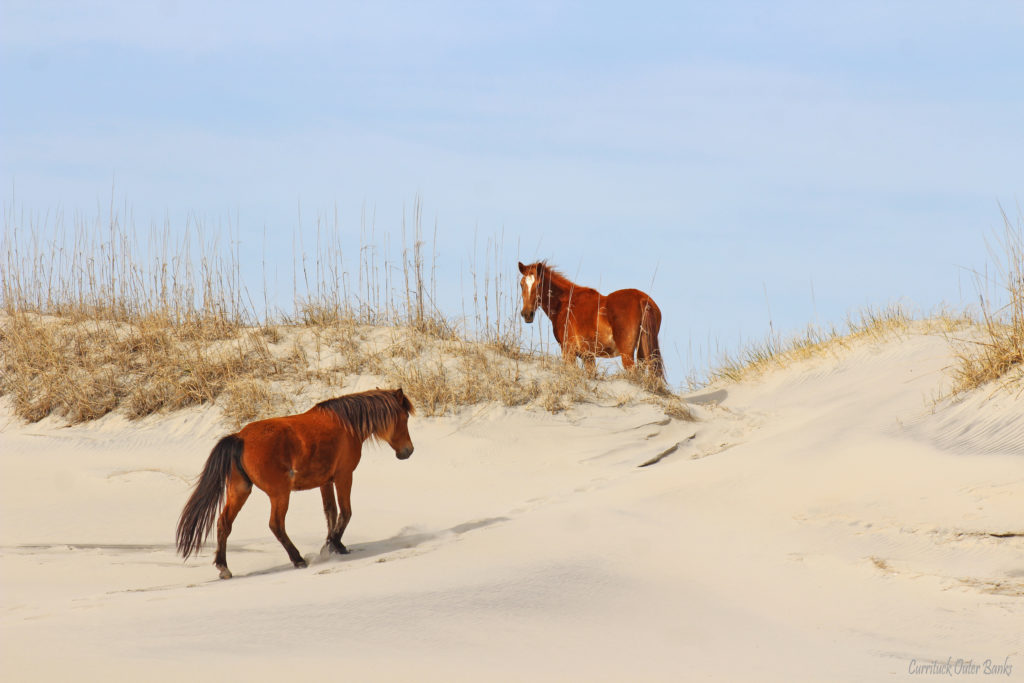
Paved Paradise to Put in a Parking Lot
The Road that Led to the Wild Horse Fund of Corolla
At one time, the road stretching from Duck to Corolla was little more than a dirt path. Paradise gave way to progress, the pathway was paved with asphalt in 1985. In the decade that followed, 20 horses were hit by cars. In 1989, a group of concerned residents recognized the need to raise public awareness of the wild horses living between the two towns and founded the Corolla Wild Horse Fund.
The CWHF worked with local government to develop a plan to protect the historic and endangered horses in their rapidly changing ecosystem. In 1996, the all-volunteer nonprofit raised $50,000 to build a sound-to-sea fence just north of Corolla. The remaining wild horses were subsequently moved to the north beaches for protection.
A second fence, 11 miles north at the Virginia state line, was also erected and financed by the group. Today, there are 7,544 acres of mixed-use land: federal, state and private-use land with more development on the horizon.
How You Can Help
Make a donation or sponsor a horse with Corolla Wild Horses (link below). The CWHF long-term goal is to raise significant funding so it can purchase more land and place it in permanent conservation easements for horses.

